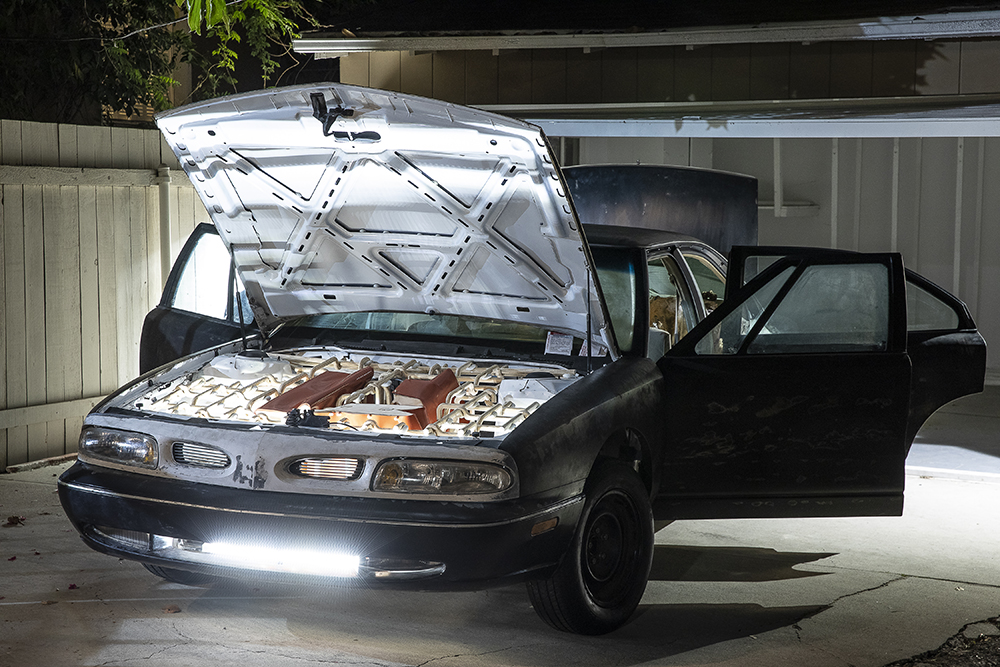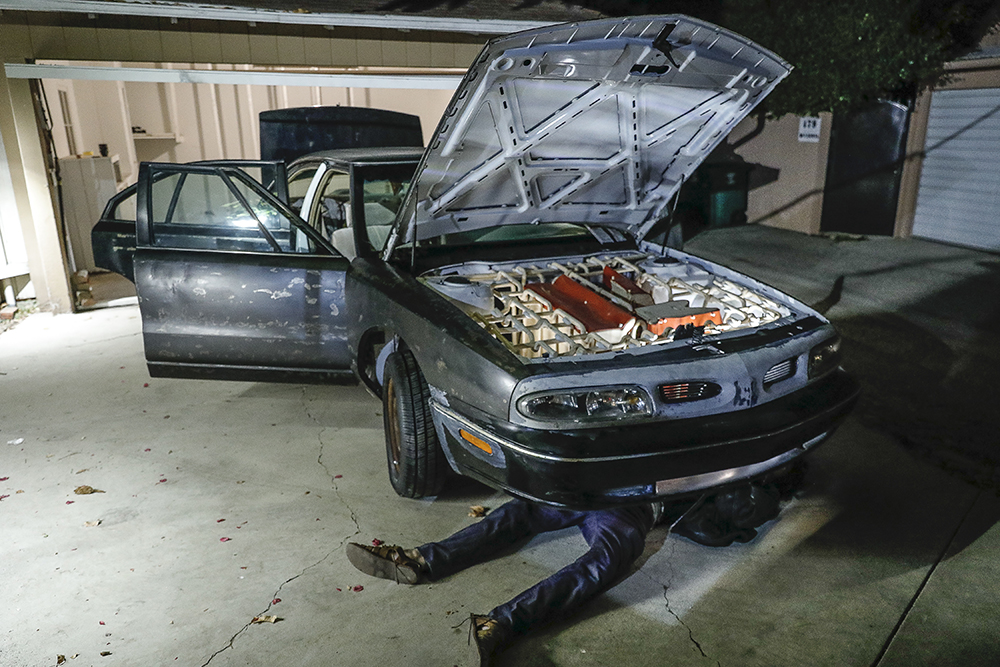Independence. Freedom. Unchecked mobility. We’re quick to attribute these qualities to the automobile: grand, sweeping, all-encompassing statements that turn the machine into an intractable, totalizing force to be glimpsed from the outside-in. We think less about the car as a collection of private spaces that each play singular roles: The war room, the kitchen, the bedroom, the sex den, the place you hide the body.
“Disassembly Line,” presented by Pietro Alexander, Sasha Filimonov and Gabriella Rothbart, investigates these interior, personal ways in which we’ve come to understand our cars. Riffing off the butchering and packaging processes of late 19th-century slaughterhouses that helped give birth to the Fordian assembly line, the curators set seven artists loose on a 1998 Oldsmobile 88––letting them gut it, manipulate it, and remake it from the ground up––in order to poke holes in the supposed intransigence of industrial systems, and obliquely, the role of the traditional gallery.
For the car is the gallery: Engine, windshield wipers, gas cap, door handles, antenna––all its functional features (except the parking brake) have been completely stripped away. A geometric floral skeleton––a ceramic signature for which Iranian sculptor Yassi Mazandi has built a reputation––blooms out of the steering wheel. Sculptor Mannix Vega, who daylights as a mechanic, painted the exterior in a gold-flecked, black matte patina and sharpened the edges of the hood, not unlike the way you’d soup up a hotrod. Except it’s not a hotrod. The car no longer functions: a point underscored by the parking tickets strewn across the windshield. Constructed by Daniel Healey, who copied, traced and duplicated real citations with vintage Letraset sheets and printer paper, the tickets combine real names, addresses, and phone numbers with snide, sarcastic comments (Terrible paint job! She lost control!) (2021) They’re so banal, so convincing in their stern straight edges and red-and-white lettering, that you have to blink to remind yourself that they’re made by hand, and fall into the realm of art.

Courtesy Spy Projects.
Pop the trunk and lift it up; you find two additional artworks. Ivan Rios-Fetchko’s Trunk (Hood) (2021), presents a quadriptych of landscapes: A vacant overpass, a concrete ribbon, a solitary tree. Painted from found slides reconfigured in the shapes of rear view mirrors––spare, lifeless scenes in oil and wax that we’ve all glimpsed from a moving car—they reflect on the automobile’s toll on our physical as well as our private mental landscapes. Reyner Banham’s ecologies come to mind. But there’s also something unsettling about roaming the open roads of radical self-realization that someone else has paved. Directly below it, Claudia Parducci’s Trunk (Body) (2021) also examines possibilities for disorder within larger systems. She has filled the trunk with playground sand; buried within it are resin-cast gas masks, shards of breathing tubes, and a single broken laptop. Even the preppers didn’t make it. Entropy ultimately prevailed.
“Disassembly Line” is hardly the first exhibition to engage with the car. Artists (especially in Los Angeles) have been dissecting them, lacquering them, repurposing them and crucifying themselves on them for decades. Nor is it the first group exhibition to play outside of the gallery’s walls (although the fact that the car was shown in the Beverly Hills garage of legendary dealer Molly Barnes, who gave John Baldessari his first solo show, was lost on no one). At times, the seven artworks therein failed to talk to one another, or conceptually meandered away from the theme. Perhaps that was inevitable, as the project’s experimental premise perfectly mirrored the title’s implied social critique. Labor was divided (none of the seven artists were really let in on what the others were up to). Workstreams were individuated (no one could anticipate how the finished product would look). Granting artists this kind of conceptual free rein was a challenge; until the last minute, the curators didn’t know what they’d be getting. “It was tough to write the press release,” Alexander said. “All we knew was that it was going to be a show in a garage with a car.”


